Since Bitcoin’s inception, blockchain technology has seen significant growth and change. This advancement has caused the internet to move from “web2” to “web3”. As a result, many companies are looking into how blockchain can address their specific business needs.
To understand blockchain better, it’s divided into two main types: public and private blockchains. Of late, many prefer using private blockchains, especially for developing decentralized applications (dApps).
Public blockchains offer numerous benefits. However, they come with risks since they are part of a shared network, which can be more vulnerable to threats.
On the other hand, private blockchains provide a higher level of security.
They allow businesses more control over who can access the blockchain, its location, and how it’s maintained. This makes private blockchains a popular choice for many companies.
Contents
- 1 What Is Private Blockchain?
- 2 Key Features of A Blockchain
- 3 Why is Private Blockchain Important?
- 4 Crucial Elements Of The Blockchain Framework
- 5 A Closer Look At A Block & its Constituents
- 6 Private Blockchain Vs. Public Blockchain
- 7 Why Establish A Private Blockchain?
- 8 The Procedure For Developing A Private Blockchain
- 9 A Guide to Constructing A Private Blockchain Using Ethereum
- 10 Webisoft Private Blockchain
- 11 End Note
- 12 Frequently Asked Questions
What Is Private Blockchain?
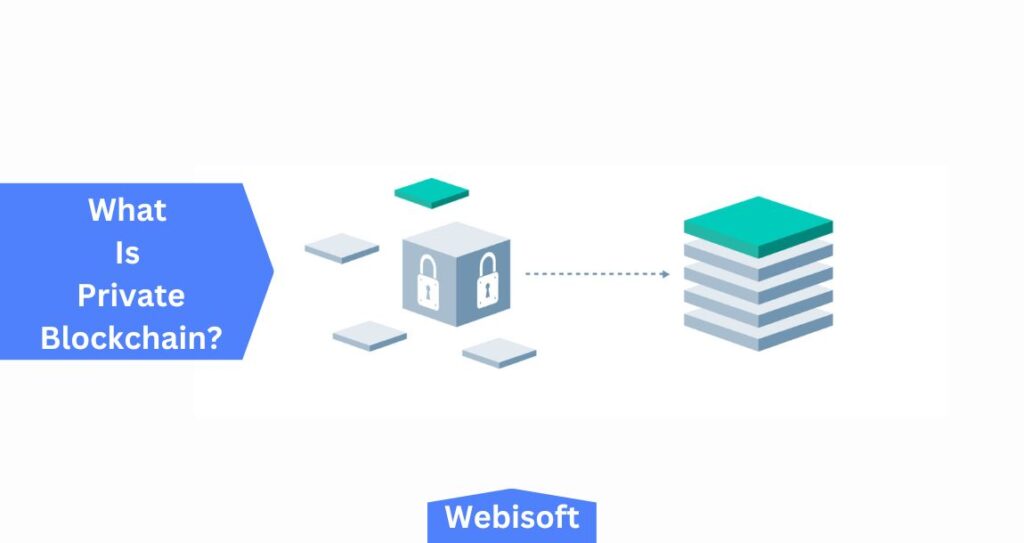
Blockchain is a P2P distributed ledger technology designed for the transparent and immutable recording of digital assets.
It operates independently, eliminating the need for an intermediary. The revolutionary technology is gaining traction due to its efficient reduction of risks and fraud.
But why are decentralized P2P networks like blockchain superior to centralized ones? The reasons lie in their enhanced reliability, privacy, and scalability, with no single point of failure.
Blockchain owes its distributed nature to shared communication and distributed processing.
Its P2P architecture has several benefits. For instance, it is more secure than traditional client-server networks.
Blockchains are shielded from malevolent activities as their distributed P2P networks need majority consensus.
Key Features of A Blockchain
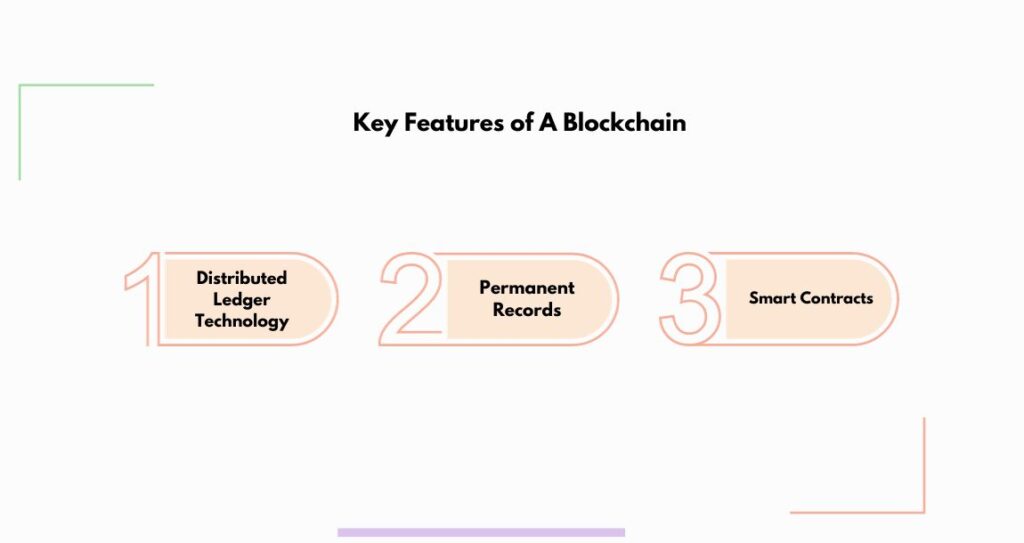
In this guide, we will delve into the key features of a blockchain. Also, we will explore the unique characteristics that have made it a game-changer in various industries.
From its decentralized nature to its unparalleled security, prepare to unravel the intricate details that make blockchain a technological marvel
1. Distributed Ledger Technology
This ledger, available to all network members, holds an immutable transaction record. This eliminates the need for recording transactions multiple times, as seen in traditional business networks.
2. Permanent Records
Once your transaction is recorded properly in the shared ledger, it is irreversible. Errors in transaction records must be corrected by rewriting the record, making both transactions visible.
3. Smart Contracts
These are a set of rules stored and automatically executed on the blockchain to expedite transactions. They help define transaction terms and conditions.
Why is Private Blockchain Important?
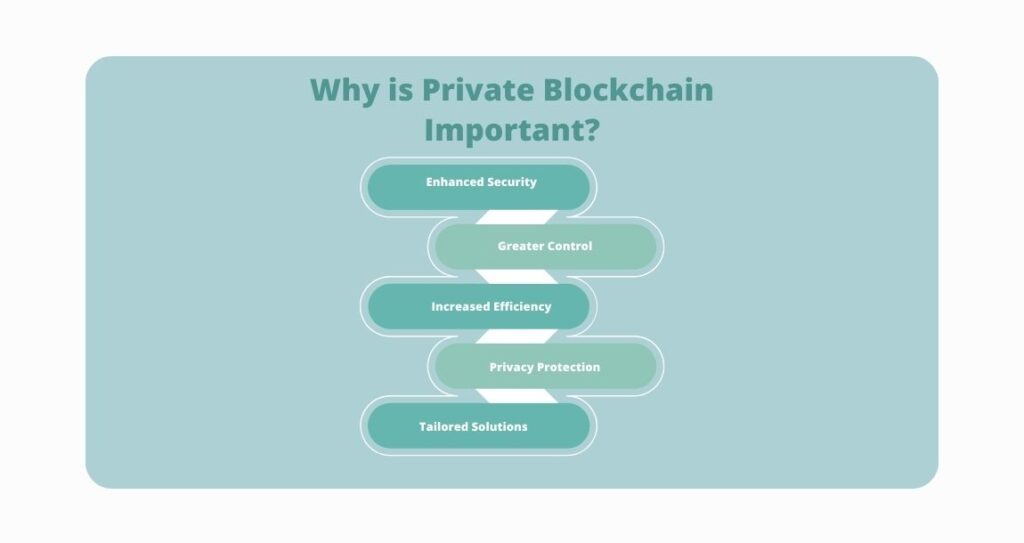
Information is vital to business success. With immediate, shared, transparent, and immutable information storage accessible only by authorized network members, blockchain is a suitable technology for storing and retrieving such data.
Blockchain networks can track orders, payments, production, and more. Its shared truth gives every transaction detail from start to end, instilling confidence and creating new exploration opportunities.
Enhanced Security
Unlike public blockchains that are open to everyone, private blockchains are restricted. This means fewer chances for hackers or unauthorized individuals to cause harm because they simply can’t access it. It’s like having a private room with a secure lock.
Greater Control
In a blockchain, a company or organization decides who can join, make transactions, or validate them. This ensures that only trusted members can participate, reducing errors or malicious activities. Think of it as a members-only club where everyone knows each other.
Increased Efficiency
With fewer participants in the network, transactions can be processed much quicker. It’s similar to having a shorter line at the checkout counter; you get through faster.
Privacy Protection
Only selected individuals or entities can view the data in a private blockchain. This is vital for businesses that maintain sensitive information, like financial records or personal details. It’s like having a diary that only you and a few trusted friends can read.
Tailored Solutions
Since a company controls its private blockchain, it can customize it to fit specific needs or preferences. It’s like building your own house, where you decide the design, color, and layout.
Crucial Elements Of The Blockchain Framework
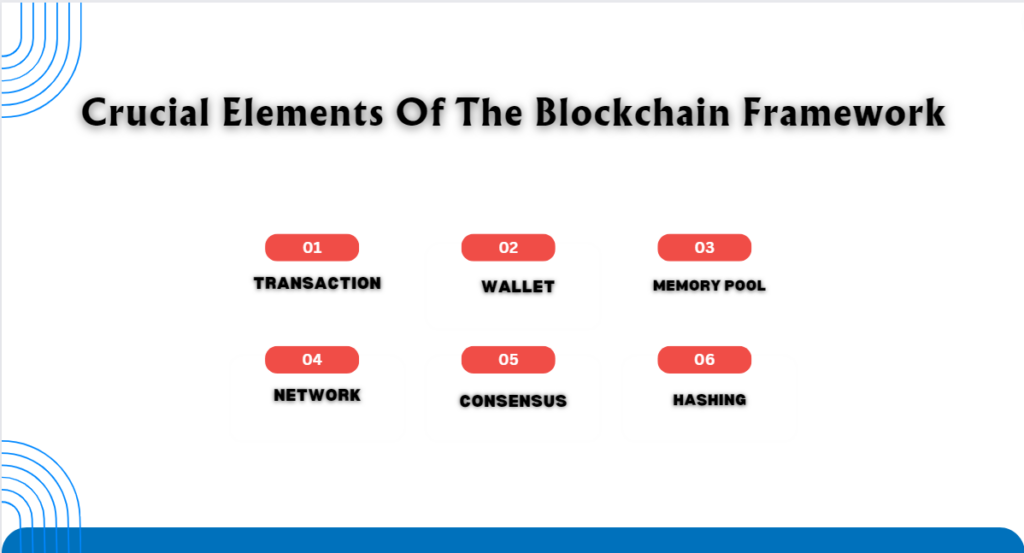
The essential elements of the blockchain framework are:
Transaction
This is the basic unit of any blockchain, comprising inputs and outputs. By understanding their inputs, outputs, and miners’ fees, we can calculate users’ wallet balances before and after transactions.
Wallet
This is your blockchain identity. It includes wallets, keys, and addresses. Wallet addresses have unique identifiers; private keys are secret numbers for crypto withdrawal, while public keys are publicly shared but cannot be used for spending cryptocurrency.
Memory pool
Transactions are stored here before addition to the blockchain. The memory pool or mempool holds transactions waiting for upload to the blockchain, which can only process a certain amount of information at a time. Backlogged information is also stored here.
Network
The blockchain network is a P2P network that operates without third-party involvement. It involves two concepts: a P2P network that allows information sharing and a distributed network for distributing information across multiple users.
Consensus
This is how blockchain makes decisions. It is a concept implemented using algorithms like Proof of Stake and Delegated Byzantine Fault Tolerance.
Hashing
Like a unique fingerprint identifying a user, hashing is a process that Proof of Work miners constantly repeat to find an eligible signature.
A Closer Look At A Block & its Constituents
To develop a private blockchain, understanding blocks is crucial. Blocks are the blockchain’s building blocks and also represent how blockchain information is stored.
- Genesis block: This is the blockchain’s first block.
- Previous block’s hash: If a block is not a Genesis block, it will contain the hash value of the previous block.
- Time: This is when the block was added to the blockchain.
- Markle root: This is calculated from each transaction pair value in the block until all hash numbers merge into one Markle root.
- Nonce: An arbitrary number that, combined with the block’s data, produces the block’s hash. This is important in mining, where miners use computation to find the block’s hash.
Private Blockchain Vs. Public Blockchain
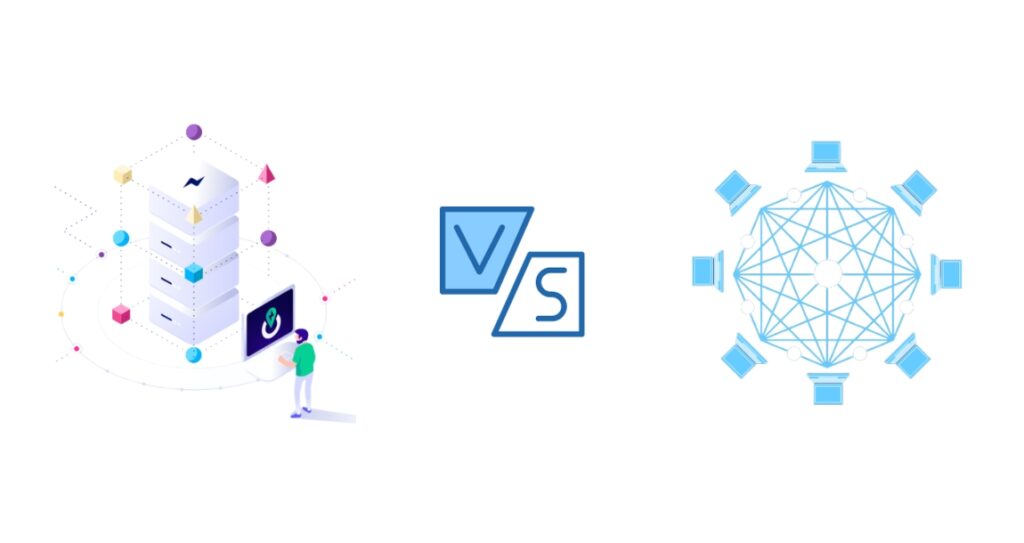
Public blockchains are permission less, allowing anyone to participate. All users have equal rights to see and verify blockchain activities, giving it a self-governing nature. Examples include Litecoin, Ethereum, and Bitcoin.
Any user can sign up to be a node on these networks, which verify transactions and maintain a copy of the distributed ledger. Similar to their public counterparts, private blockchains are digital ledger technologies that are centrally managed.
The central authority determines participation, transaction verification, and ledger maintenance. They’re not entirely decentralized, with restricted public access, serving as a more sensible option for organizations who see the benefits of blockchain.
Comparing Private & Public Blockchains
| Feature | Public Blockchain | Private Blockchain |
| Access | Open to All | Restricted to a Specific Organization |
| Authority | Decentralised | Semi-Decentralized |
| Transaction Speed | Slow | Fast |
| Consensus | Permissionless | Permissioned |
| Transaction Cost | High | Low |
| Data Handling | Everyone has Read-Write Access | Read-Write Access Limited to the Organization |
| Immutability | Complete | Partial |
| Efficiency | Low | High |
Why Establish A Private Blockchain?
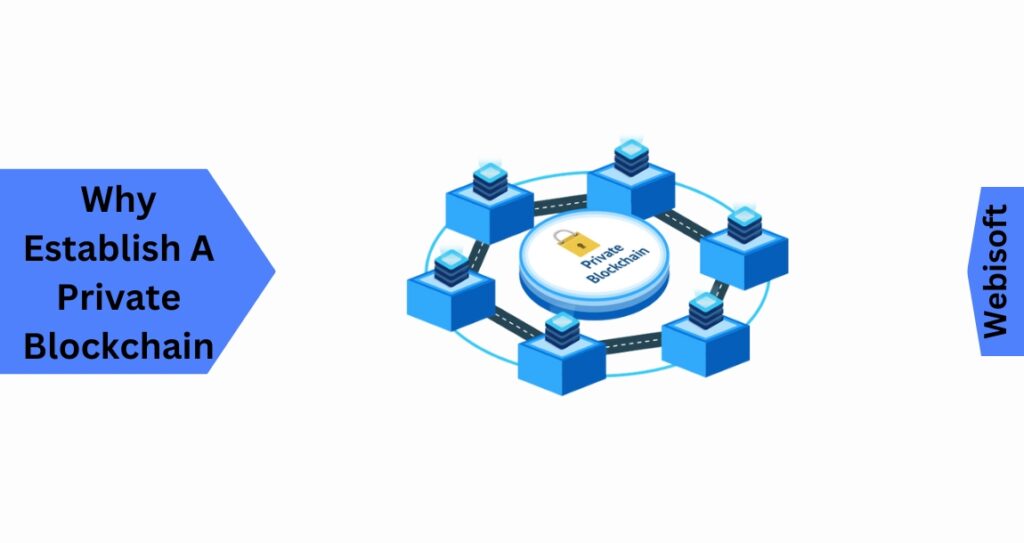
Creating a private blockchain has numerous benefits:
Energy Efficiency
Unlike the energy-hungry process of Bitcoin mining, private blockchains offer pre-mined coins, making it more energy-friendly.
Reduced Volatility
The daily regulation of private blockchains makes them less susceptible to unpredictable price fluctuations seen in public blockchain cryptocurrencies.
Enhanced Accessibility
Numerous private blockchains allow collaborations with banks and financial institutions, making the technology more user-friendly.
Prevention of Illegal Activities
Private blockchains have selective entry, restricting illicit activities common with some cryptocurrencies. Only authorized individuals have access, effectively reducing unlawful actions.
Enterprise Empowerment
Typically, private networks focus on enhancing the organization’s success rather than individual achievements, fostering revenue growth and overall business development. They can also be used to establish enterprise blockchain platforms.
Improved Security
As permissioned networks, individuals require consent to join and operate, reducing the chance of private data exposure.
Lower Operational Costs
Direct interactions with other businesses without intermediaries significantly cut costs.
Transparency and Anonymity
All users can view every activity on the private blockchain. Specific users can also be anonymized if suitable for your business model.
Performance Coupled with Data Integrity
Blockchain transactions can sometimes take hours, depending on transaction volume and associated fees.
The Procedure For Developing A Private Blockchain
If you prefer not to use a public blockchain for your needs and want to establish your own private network instead, the following methodology will guide you:
Step 1: Select The Protocol
Firstly, choose a blockchain framework. Here are a few options:
- An EVM-based protocol for Ethereum compatibility
- The Substrate framework for a secure, rapid, cost-effective, and well-supported blockchain development experience
- Cosmos or Provenance to create a scalable private blockchain ecosystem
- Forking an existing protocol
Step 2: Construct The Core Logic
After selecting the protocol, construct the core logic of your private blockchain, which includes:
- Modifying the existing logic
- Determining the consensus algorithm
- Setting the transaction fee
- Enhancing header information
- Adjusting block height
- Building pallets
- Selecting an appropriate permission module
- Choosing the suitable file storage option for your chain
Step 3: Develop The Logic
Upon establishing the core logic, enter the DevOps phase, which encompasses:
- Hosting a test network
- Finalizing your chain’s file storage
- Creating a Genesis key store
- Deciding on the launch node count and their geographical regions
- Integrating APIs for free information exchange with external sources
Step 4: Testing
After concluding the DevOps phase, launch your test network. Test your faucet, wallet, block explorer, and SDKs, employing a dedicated benchmarking and monitoring tool. The comprehensive testing procedure includes:
- Checking the seamless operation of all integrations
- Assessing the blockchain network’s scalability
- Confirming the blockchain’s functionality
- Identifying and rectifying blockchain security vulnerabilities
- Resolving network connectivity issues
- Testing network migration possibility
- Evaluating the chain’s performance
Step 5: Launch the Main Network
Once the testing phase concludes and all detected issues are resolved, you can launch the main network.
Step 6: Network Integration
Finally, integrate your faucet, wallet, block explorer, benchmarking and monitoring tool, and SDKs with the main net. With this step, your private blockchain network is set and ready.
A Guide to Constructing A Private Blockchain Using Ethereum
In the ever-evolving blockchain world, a private blockchain utilizing Ethereum is a powerful tool for various industries, from finance to healthcare. This in-depth guide takes you through the creation of your very own private Ethereum blockchain.
The Ethereum network is a mesh of interconnected nodes or EVMs (Ethereum Virtual Machines). Each node, containing a duplicate of the entire blockchain, can mine the subsequent block. They are expanding the blockchain and broadcasting the update to the entire network.
To become a node in the Ethereum network, you’ll need to install the complete Ethereum blockchain on your computer.
This can be accomplished with Ethereum tools that allow your computer to download and interface with the Ethereum network. An essential tool is Geth, which we’ll discuss further.
Understanding Geth
Geth, the Go implementation for Ethereum, is a Command Line Interface (CLI). It provides a conduit between your computer, its hardware, and the other nodes within the Ethereum network.
When another node mines a block, Geth alerts your CPU or GPU or to update your blockchain. Geth enables you to:
- Mine Ether, the driving cryptocurrency behind the Ethereum network
- Transfer funds between different addresses
- Establish smart contracts and send transactions
- Examine block history and more
How to Install Geth
On macOS
1. Begin by installing Geth through the Geth Homebrew tap. Check whether Homebrew is installed on your computer. If not, you can install Homebrew here.
2. After installing the Homebrew, you can use the following commands to add the Geth tap and install Geth:
bash
brew tap Ethereum/Ethereum
brew install ethereum
3. To install the master branch of the Geth repository, use the –devel parameter in the install command:
CSS brew install Ethereum –devel
4. The above commands install core Geth software and the following developer tools: devp2p, clef, boot node, evm, rlpdump, puppeth, and abigen. All tool binaries are saved in /usr/local/bin/. A full list of command-line options can be obtained by running geth –help.
To update Geth to its latest version, stop the node and run these commands:
SQL
brew update
brew upgrade
brew reinstall Ethereum
5. Now, you can restart Geth, which will utilize the previous data to sync any unavailable blocks while it is offline.
Post-Installation Steps
After installing Geth, you can reach to the main Ethereum blockchain network or establish a fully custom Ethereum network. Even if you don’t own Ether, Geth allows the creation of a private Ethereum blockchain network.
It functions as a development or staging network mirroring the main Ethereum network. This private network enables you to create smart contracts, make transactions, and distribute apps without the need for real Ether.
Creating The Genesis Block
A blockchain is a public, chronological record of transactions stored in blocks. To create a private blockchain, you first need to create a Genesis block.
For this, you’ll need to create a custom Genesis file and instruct Geth to use it to create your private blockchain.
Here is an example of what a Genesis file looks like:
JSON
{
“config”: {
“chained”: 15,
“homesteadBlock”: 0,
“eip155Block”: 0,
“eip158Block”: 0
},
“nonce”: “0x0000000000000042”,
“timestamp”: “0x00”,
“parentHash”: “0x0000000000000000000000000000000000000000000000000000000000000000”,
“extraData”: “0x00”,
“gasLimit”: “0x08000000”,
“difficulty”: “0x400”,
“mixhash”: “0x0000000000000000000000000000000000000000000000000000000000000000”,
“coinbase”: “0x3333333333333333333333333333333333333333”,
“alloc”: {}
}
Next, create a CustomGenesis.json file in a folder on your system and run this command:
bash
geth — identity “yourIdentity” — init /path_to_folder/CustomGenesis.json — data-dir /path_to_your_data_directory/ACP
Generating A Private Network To Share The Blockchain
Having created the genesis of our private blockchain, we’ll now start our private network to mine new blocks. The following command achieves this:
CSS
geth –data-dir /path_to_your_data_directory/ACPrivateChain –networkid 9876
Upon running this command, your private network will be activated.
Webisoft Private Blockchain
Webisoft offers a unique private blockchain solution tailored to meet the modern businesses’ all needs. With a focus on simplicity, security, and efficiency, Webisoft’s private blockchain is designed for those seeking a reliable and easy-to-use platform. Some of our blockchain services are:
- Blockchain Consulting: Our blockchain experts will guide you on everything related to blockchain. They’ll examine your business needs, study the market, and suggest the latest ideas.
- Smart Contracts Development: We make safe and tailored smart contracts. They also use less Ethereum gas.
- Custom Blockchain Development: We can make special blockchains just for you, along with other applications and services using blockchain.
- DeFi Development: We make financial tools using blockchain. We use platforms like Ethereum, EOS, Tron, and Bitcoin.
- dApp Development: Our skilled team can create secure and big apps that work on a decentralized system.
End Note
Private blockchains hold immense potential as they offer robust, scalable, and highly secure database services to various organizations. They provide clear visibility into supply chains, thus reducing waste and identifying defects.
Furthermore, as private blockchains typically operate within a smaller network with fewer participants, they offer easier management and lower downtime.
Compliance management is also simplified within a private blockchain ecosystem. Overall, private blockchains are efficiently enhancing enterprises’ success and scalability.
Frequently Asked Questions
How does a private blockchain maintain user privacy?
Only selected participants can view the data, ensuring that sensitive information remains confidential within the network.
Are private blockchains faster than public ones?
Generally, yes. With fewer participants, transactions in private blockchains are often more streamlined and efficient.
What are the limitations of a private blockchain?
Since it’s more centralized, it may not offer the same level of decentralization or transparency as public blockchains.
Why are businesses leaning towards private blockchain adoption?
Private blockchains offer security, control, and customization, making them ideal for business operations that prioritize these aspects.
Is A Private Blockchain Really A Blockchain?
Yes, a private blockchain is still a blockchain as it retains the foundational elements of a blockchain: decentralization, immutability, and transparency.
However, these elements can be customized based on the level of privacy and centralization desired.
